UK Taxation Report: Employment, Self-Employment, and Tax Implications
VerifiedAdded on 2021/10/16
|7
|2926
|36
Report
AI Summary
This report offers a detailed analysis of the UK taxation system, addressing key aspects such as the distinction between employment and self-employment, including real-life case studies like the HMRC vs. BBC presenter case. It differentiates between tax avoidance and tax evasion, outlining their legal and illegal implications, and provides examples such as the Gary Barlow icebreaker scheme and the HSBC tax evasion scandal. The report also covers various types of taxes levied in the UK, including income tax, capital gains tax, corporation tax, VAT, excise duties, stamp duty, and inheritance tax, explaining their purposes and applications. Furthermore, it explores the 'badges of trade,' which are critical in determining whether an activity constitutes a trade or an investment, providing insights into profit-seeking motives, frequency of transactions, and asset modification. The report aims to provide a comprehensive understanding of the UK taxation landscape.

UK TAXATION
Paraphrase This Document
Need a fresh take? Get an instant paraphrase of this document with our AI Paraphraser
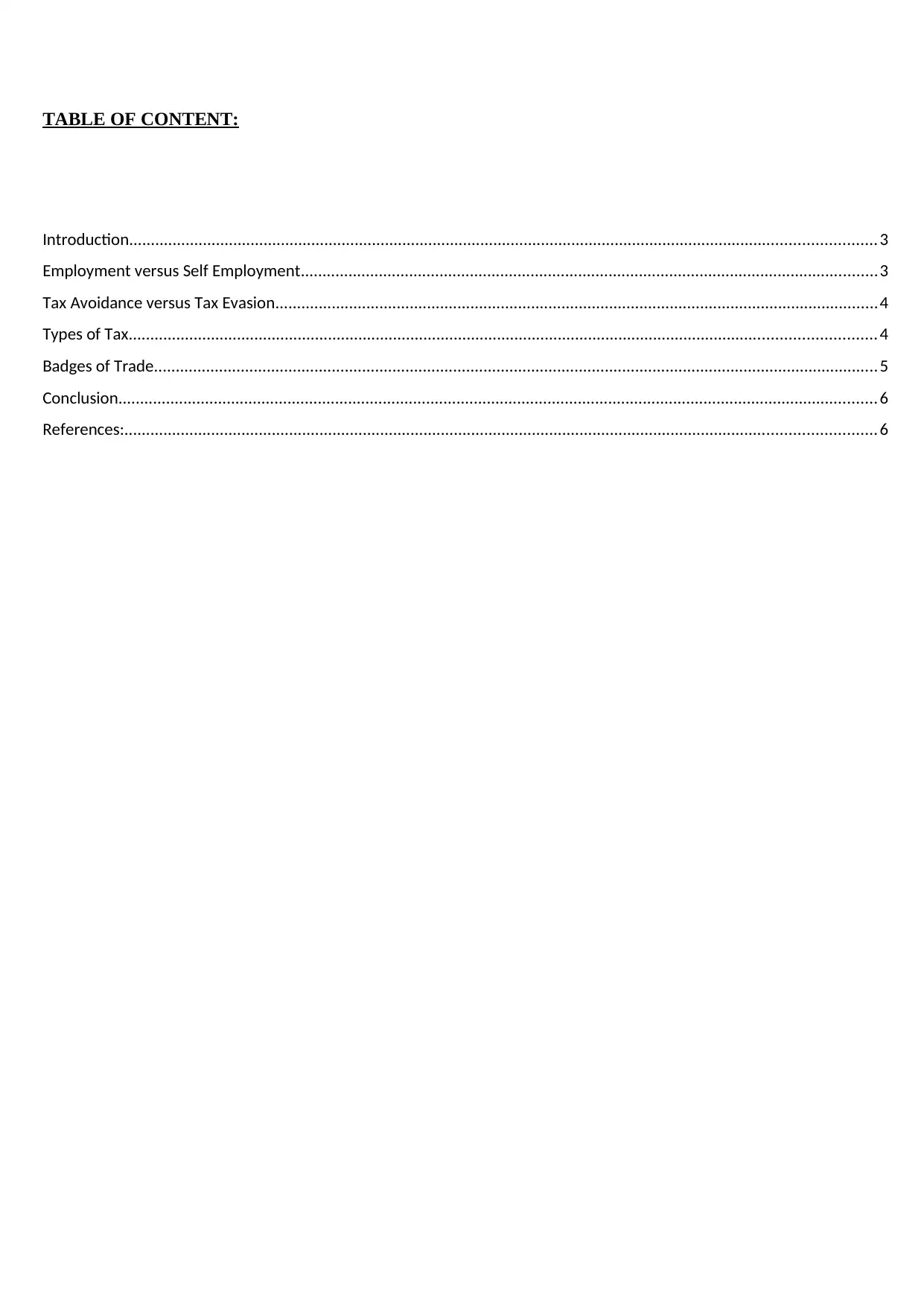
TABLE OF CONTENT:
Introduction............................................................................................................................................................................ 3
Employment versus Self Employment.....................................................................................................................................3
Tax Avoidance versus Tax Evasion...........................................................................................................................................4
Types of Tax............................................................................................................................................................................ 4
Badges of Trade....................................................................................................................................................................... 5
Conclusion............................................................................................................................................................................... 6
References:............................................................................................................................................................................. 6
Introduction............................................................................................................................................................................ 3
Employment versus Self Employment.....................................................................................................................................3
Tax Avoidance versus Tax Evasion...........................................................................................................................................4
Types of Tax............................................................................................................................................................................ 4
Badges of Trade....................................................................................................................................................................... 5
Conclusion............................................................................................................................................................................... 6
References:............................................................................................................................................................................. 6
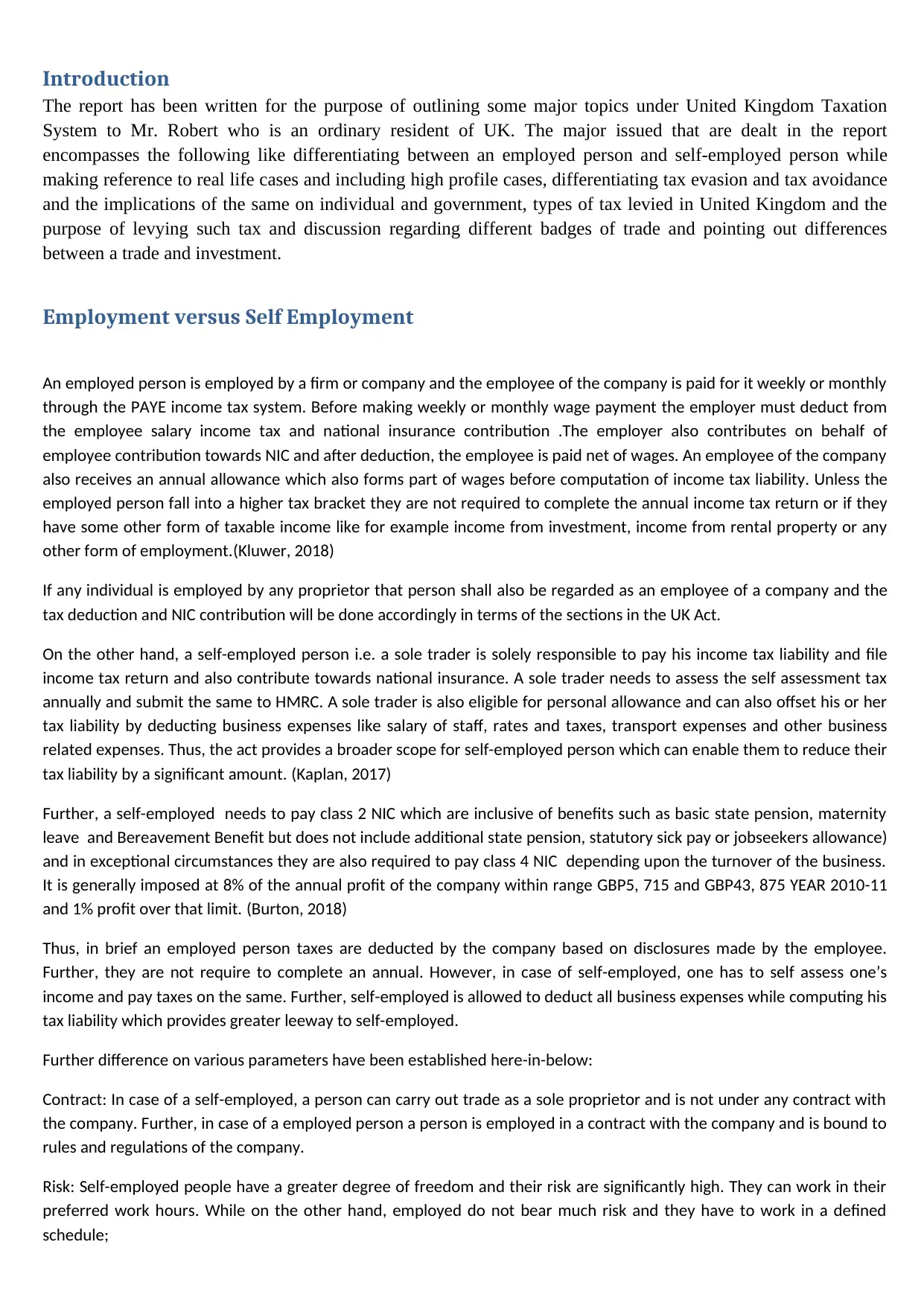
Introduction
The report has been written for the purpose of outlining some major topics under United Kingdom Taxation
System to Mr. Robert who is an ordinary resident of UK. The major issued that are dealt in the report
encompasses the following like differentiating between an employed person and self-employed person while
making reference to real life cases and including high profile cases, differentiating tax evasion and tax avoidance
and the implications of the same on individual and government, types of tax levied in United Kingdom and the
purpose of levying such tax and discussion regarding different badges of trade and pointing out differences
between a trade and investment.
Employment versus Self Employment
An employed person is employed by a firm or company and the employee of the company is paid for it weekly or monthly
through the PAYE income tax system. Before making weekly or monthly wage payment the employer must deduct from
the employee salary income tax and national insurance contribution .The employer also contributes on behalf of
employee contribution towards NIC and after deduction, the employee is paid net of wages. An employee of the company
also receives an annual allowance which also forms part of wages before computation of income tax liability. Unless the
employed person fall into a higher tax bracket they are not required to complete the annual income tax return or if they
have some other form of taxable income like for example income from investment, income from rental property or any
other form of employment.(Kluwer, 2018)
If any individual is employed by any proprietor that person shall also be regarded as an employee of a company and the
tax deduction and NIC contribution will be done accordingly in terms of the sections in the UK Act.
On the other hand, a self-employed person i.e. a sole trader is solely responsible to pay his income tax liability and file
income tax return and also contribute towards national insurance. A sole trader needs to assess the self assessment tax
annually and submit the same to HMRC. A sole trader is also eligible for personal allowance and can also offset his or her
tax liability by deducting business expenses like salary of staff, rates and taxes, transport expenses and other business
related expenses. Thus, the act provides a broader scope for self-employed person which can enable them to reduce their
tax liability by a significant amount. (Kaplan, 2017)
Further, a self-employed needs to pay class 2 NIC which are inclusive of benefits such as basic state pension, maternity
leave and Bereavement Benefit but does not include additional state pension, statutory sick pay or jobseekers allowance)
and in exceptional circumstances they are also required to pay class 4 NIC depending upon the turnover of the business.
It is generally imposed at 8% of the annual profit of the company within range GBP5, 715 and GBP43, 875 YEAR 2010-11
and 1% profit over that limit. (Burton, 2018)
Thus, in brief an employed person taxes are deducted by the company based on disclosures made by the employee.
Further, they are not require to complete an annual. However, in case of self-employed, one has to self assess one’s
income and pay taxes on the same. Further, self-employed is allowed to deduct all business expenses while computing his
tax liability which provides greater leeway to self-employed.
Further difference on various parameters have been established here-in-below:
Contract: In case of a self-employed, a person can carry out trade as a sole proprietor and is not under any contract with
the company. Further, in case of a employed person a person is employed in a contract with the company and is bound to
rules and regulations of the company.
Risk: Self-employed people have a greater degree of freedom and their risk are significantly high. They can work in their
preferred work hours. While on the other hand, employed do not bear much risk and they have to work in a defined
schedule;
The report has been written for the purpose of outlining some major topics under United Kingdom Taxation
System to Mr. Robert who is an ordinary resident of UK. The major issued that are dealt in the report
encompasses the following like differentiating between an employed person and self-employed person while
making reference to real life cases and including high profile cases, differentiating tax evasion and tax avoidance
and the implications of the same on individual and government, types of tax levied in United Kingdom and the
purpose of levying such tax and discussion regarding different badges of trade and pointing out differences
between a trade and investment.
Employment versus Self Employment
An employed person is employed by a firm or company and the employee of the company is paid for it weekly or monthly
through the PAYE income tax system. Before making weekly or monthly wage payment the employer must deduct from
the employee salary income tax and national insurance contribution .The employer also contributes on behalf of
employee contribution towards NIC and after deduction, the employee is paid net of wages. An employee of the company
also receives an annual allowance which also forms part of wages before computation of income tax liability. Unless the
employed person fall into a higher tax bracket they are not required to complete the annual income tax return or if they
have some other form of taxable income like for example income from investment, income from rental property or any
other form of employment.(Kluwer, 2018)
If any individual is employed by any proprietor that person shall also be regarded as an employee of a company and the
tax deduction and NIC contribution will be done accordingly in terms of the sections in the UK Act.
On the other hand, a self-employed person i.e. a sole trader is solely responsible to pay his income tax liability and file
income tax return and also contribute towards national insurance. A sole trader needs to assess the self assessment tax
annually and submit the same to HMRC. A sole trader is also eligible for personal allowance and can also offset his or her
tax liability by deducting business expenses like salary of staff, rates and taxes, transport expenses and other business
related expenses. Thus, the act provides a broader scope for self-employed person which can enable them to reduce their
tax liability by a significant amount. (Kaplan, 2017)
Further, a self-employed needs to pay class 2 NIC which are inclusive of benefits such as basic state pension, maternity
leave and Bereavement Benefit but does not include additional state pension, statutory sick pay or jobseekers allowance)
and in exceptional circumstances they are also required to pay class 4 NIC depending upon the turnover of the business.
It is generally imposed at 8% of the annual profit of the company within range GBP5, 715 and GBP43, 875 YEAR 2010-11
and 1% profit over that limit. (Burton, 2018)
Thus, in brief an employed person taxes are deducted by the company based on disclosures made by the employee.
Further, they are not require to complete an annual. However, in case of self-employed, one has to self assess one’s
income and pay taxes on the same. Further, self-employed is allowed to deduct all business expenses while computing his
tax liability which provides greater leeway to self-employed.
Further difference on various parameters have been established here-in-below:
Contract: In case of a self-employed, a person can carry out trade as a sole proprietor and is not under any contract with
the company. Further, in case of a employed person a person is employed in a contract with the company and is bound to
rules and regulations of the company.
Risk: Self-employed people have a greater degree of freedom and their risk are significantly high. They can work in their
preferred work hours. While on the other hand, employed do not bear much risk and they have to work in a defined
schedule;
⊘ This is a preview!⊘
Do you want full access?
Subscribe today to unlock all pages.

Trusted by 1+ million students worldwide
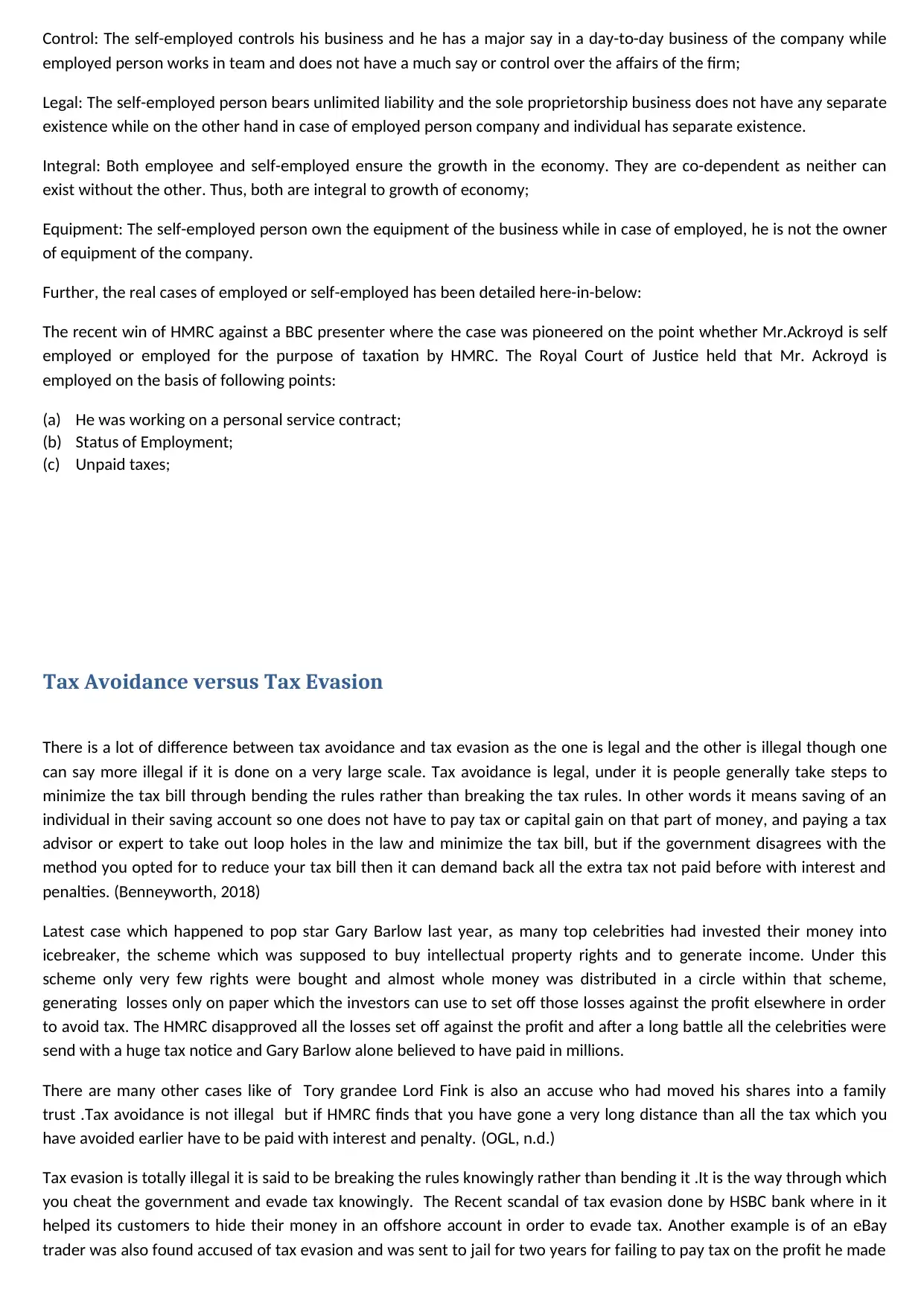
Control: The self-employed controls his business and he has a major say in a day-to-day business of the company while
employed person works in team and does not have a much say or control over the affairs of the firm;
Legal: The self-employed person bears unlimited liability and the sole proprietorship business does not have any separate
existence while on the other hand in case of employed person company and individual has separate existence.
Integral: Both employee and self-employed ensure the growth in the economy. They are co-dependent as neither can
exist without the other. Thus, both are integral to growth of economy;
Equipment: The self-employed person own the equipment of the business while in case of employed, he is not the owner
of equipment of the company.
Further, the real cases of employed or self-employed has been detailed here-in-below:
The recent win of HMRC against a BBC presenter where the case was pioneered on the point whether Mr.Ackroyd is self
employed or employed for the purpose of taxation by HMRC. The Royal Court of Justice held that Mr. Ackroyd is
employed on the basis of following points:
(a) He was working on a personal service contract;
(b) Status of Employment;
(c) Unpaid taxes;
Tax Avoidance versus Tax Evasion
There is a lot of difference between tax avoidance and tax evasion as the one is legal and the other is illegal though one
can say more illegal if it is done on a very large scale. Tax avoidance is legal, under it is people generally take steps to
minimize the tax bill through bending the rules rather than breaking the tax rules. In other words it means saving of an
individual in their saving account so one does not have to pay tax or capital gain on that part of money, and paying a tax
advisor or expert to take out loop holes in the law and minimize the tax bill, but if the government disagrees with the
method you opted for to reduce your tax bill then it can demand back all the extra tax not paid before with interest and
penalties. (Benneyworth, 2018)
Latest case which happened to pop star Gary Barlow last year, as many top celebrities had invested their money into
icebreaker, the scheme which was supposed to buy intellectual property rights and to generate income. Under this
scheme only very few rights were bought and almost whole money was distributed in a circle within that scheme,
generating losses only on paper which the investors can use to set off those losses against the profit elsewhere in order
to avoid tax. The HMRC disapproved all the losses set off against the profit and after a long battle all the celebrities were
send with a huge tax notice and Gary Barlow alone believed to have paid in millions.
There are many other cases like of Tory grandee Lord Fink is also an accuse who had moved his shares into a family
trust .Tax avoidance is not illegal but if HMRC finds that you have gone a very long distance than all the tax which you
have avoided earlier have to be paid with interest and penalty. (OGL, n.d.)
Tax evasion is totally illegal it is said to be breaking the rules knowingly rather than bending it .It is the way through which
you cheat the government and evade tax knowingly. The Recent scandal of tax evasion done by HSBC bank where in it
helped its customers to hide their money in an offshore account in order to evade tax. Another example is of an eBay
trader was also found accused of tax evasion and was sent to jail for two years for failing to pay tax on the profit he made
employed person works in team and does not have a much say or control over the affairs of the firm;
Legal: The self-employed person bears unlimited liability and the sole proprietorship business does not have any separate
existence while on the other hand in case of employed person company and individual has separate existence.
Integral: Both employee and self-employed ensure the growth in the economy. They are co-dependent as neither can
exist without the other. Thus, both are integral to growth of economy;
Equipment: The self-employed person own the equipment of the business while in case of employed, he is not the owner
of equipment of the company.
Further, the real cases of employed or self-employed has been detailed here-in-below:
The recent win of HMRC against a BBC presenter where the case was pioneered on the point whether Mr.Ackroyd is self
employed or employed for the purpose of taxation by HMRC. The Royal Court of Justice held that Mr. Ackroyd is
employed on the basis of following points:
(a) He was working on a personal service contract;
(b) Status of Employment;
(c) Unpaid taxes;
Tax Avoidance versus Tax Evasion
There is a lot of difference between tax avoidance and tax evasion as the one is legal and the other is illegal though one
can say more illegal if it is done on a very large scale. Tax avoidance is legal, under it is people generally take steps to
minimize the tax bill through bending the rules rather than breaking the tax rules. In other words it means saving of an
individual in their saving account so one does not have to pay tax or capital gain on that part of money, and paying a tax
advisor or expert to take out loop holes in the law and minimize the tax bill, but if the government disagrees with the
method you opted for to reduce your tax bill then it can demand back all the extra tax not paid before with interest and
penalties. (Benneyworth, 2018)
Latest case which happened to pop star Gary Barlow last year, as many top celebrities had invested their money into
icebreaker, the scheme which was supposed to buy intellectual property rights and to generate income. Under this
scheme only very few rights were bought and almost whole money was distributed in a circle within that scheme,
generating losses only on paper which the investors can use to set off those losses against the profit elsewhere in order
to avoid tax. The HMRC disapproved all the losses set off against the profit and after a long battle all the celebrities were
send with a huge tax notice and Gary Barlow alone believed to have paid in millions.
There are many other cases like of Tory grandee Lord Fink is also an accuse who had moved his shares into a family
trust .Tax avoidance is not illegal but if HMRC finds that you have gone a very long distance than all the tax which you
have avoided earlier have to be paid with interest and penalty. (OGL, n.d.)
Tax evasion is totally illegal it is said to be breaking the rules knowingly rather than bending it .It is the way through which
you cheat the government and evade tax knowingly. The Recent scandal of tax evasion done by HSBC bank where in it
helped its customers to hide their money in an offshore account in order to evade tax. Another example is of an eBay
trader was also found accused of tax evasion and was sent to jail for two years for failing to pay tax on the profit he made
Paraphrase This Document
Need a fresh take? Get an instant paraphrase of this document with our AI Paraphraser
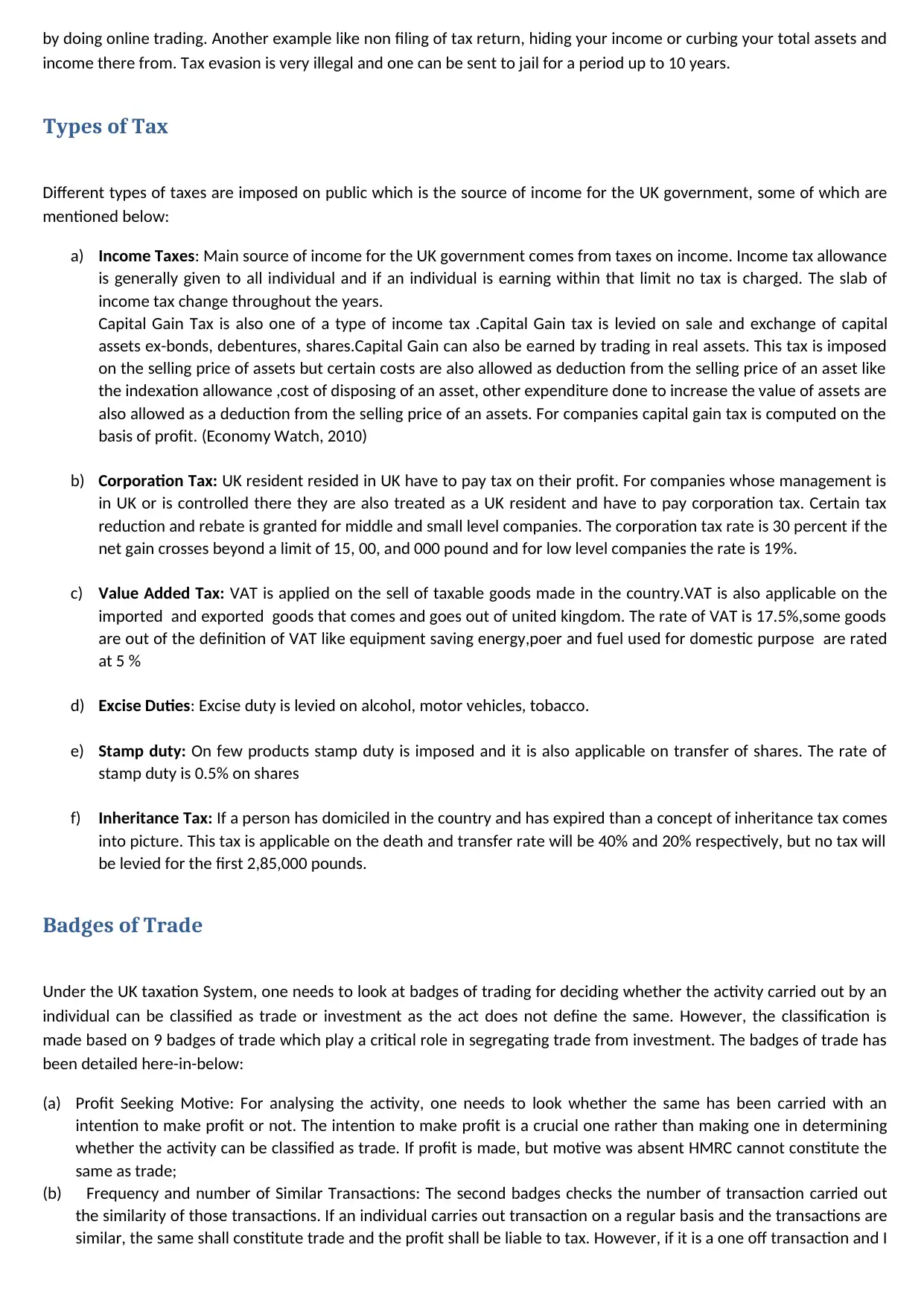
by doing online trading. Another example like non filing of tax return, hiding your income or curbing your total assets and
income there from. Tax evasion is very illegal and one can be sent to jail for a period up to 10 years.
Types of Tax
Different types of taxes are imposed on public which is the source of income for the UK government, some of which are
mentioned below:
a) Income Taxes: Main source of income for the UK government comes from taxes on income. Income tax allowance
is generally given to all individual and if an individual is earning within that limit no tax is charged. The slab of
income tax change throughout the years.
Capital Gain Tax is also one of a type of income tax .Capital Gain tax is levied on sale and exchange of capital
assets ex-bonds, debentures, shares.Capital Gain can also be earned by trading in real assets. This tax is imposed
on the selling price of assets but certain costs are also allowed as deduction from the selling price of an asset like
the indexation allowance ,cost of disposing of an asset, other expenditure done to increase the value of assets are
also allowed as a deduction from the selling price of an assets. For companies capital gain tax is computed on the
basis of profit. (Economy Watch, 2010)
b) Corporation Tax: UK resident resided in UK have to pay tax on their profit. For companies whose management is
in UK or is controlled there they are also treated as a UK resident and have to pay corporation tax. Certain tax
reduction and rebate is granted for middle and small level companies. The corporation tax rate is 30 percent if the
net gain crosses beyond a limit of 15, 00, and 000 pound and for low level companies the rate is 19%.
c) Value Added Tax: VAT is applied on the sell of taxable goods made in the country.VAT is also applicable on the
imported and exported goods that comes and goes out of united kingdom. The rate of VAT is 17.5%,some goods
are out of the definition of VAT like equipment saving energy,poer and fuel used for domestic purpose are rated
at 5 %
d) Excise Duties: Excise duty is levied on alcohol, motor vehicles, tobacco.
e) Stamp duty: On few products stamp duty is imposed and it is also applicable on transfer of shares. The rate of
stamp duty is 0.5% on shares
f) Inheritance Tax: If a person has domiciled in the country and has expired than a concept of inheritance tax comes
into picture. This tax is applicable on the death and transfer rate will be 40% and 20% respectively, but no tax will
be levied for the first 2,85,000 pounds.
Badges of Trade
Under the UK taxation System, one needs to look at badges of trading for deciding whether the activity carried out by an
individual can be classified as trade or investment as the act does not define the same. However, the classification is
made based on 9 badges of trade which play a critical role in segregating trade from investment. The badges of trade has
been detailed here-in-below:
(a) Profit Seeking Motive: For analysing the activity, one needs to look whether the same has been carried with an
intention to make profit or not. The intention to make profit is a crucial one rather than making one in determining
whether the activity can be classified as trade. If profit is made, but motive was absent HMRC cannot constitute the
same as trade;
(b) Frequency and number of Similar Transactions: The second badges checks the number of transaction carried out
the similarity of those transactions. If an individual carries out transaction on a regular basis and the transactions are
similar, the same shall constitute trade and the profit shall be liable to tax. However, if it is a one off transaction and I
income there from. Tax evasion is very illegal and one can be sent to jail for a period up to 10 years.
Types of Tax
Different types of taxes are imposed on public which is the source of income for the UK government, some of which are
mentioned below:
a) Income Taxes: Main source of income for the UK government comes from taxes on income. Income tax allowance
is generally given to all individual and if an individual is earning within that limit no tax is charged. The slab of
income tax change throughout the years.
Capital Gain Tax is also one of a type of income tax .Capital Gain tax is levied on sale and exchange of capital
assets ex-bonds, debentures, shares.Capital Gain can also be earned by trading in real assets. This tax is imposed
on the selling price of assets but certain costs are also allowed as deduction from the selling price of an asset like
the indexation allowance ,cost of disposing of an asset, other expenditure done to increase the value of assets are
also allowed as a deduction from the selling price of an assets. For companies capital gain tax is computed on the
basis of profit. (Economy Watch, 2010)
b) Corporation Tax: UK resident resided in UK have to pay tax on their profit. For companies whose management is
in UK or is controlled there they are also treated as a UK resident and have to pay corporation tax. Certain tax
reduction and rebate is granted for middle and small level companies. The corporation tax rate is 30 percent if the
net gain crosses beyond a limit of 15, 00, and 000 pound and for low level companies the rate is 19%.
c) Value Added Tax: VAT is applied on the sell of taxable goods made in the country.VAT is also applicable on the
imported and exported goods that comes and goes out of united kingdom. The rate of VAT is 17.5%,some goods
are out of the definition of VAT like equipment saving energy,poer and fuel used for domestic purpose are rated
at 5 %
d) Excise Duties: Excise duty is levied on alcohol, motor vehicles, tobacco.
e) Stamp duty: On few products stamp duty is imposed and it is also applicable on transfer of shares. The rate of
stamp duty is 0.5% on shares
f) Inheritance Tax: If a person has domiciled in the country and has expired than a concept of inheritance tax comes
into picture. This tax is applicable on the death and transfer rate will be 40% and 20% respectively, but no tax will
be levied for the first 2,85,000 pounds.
Badges of Trade
Under the UK taxation System, one needs to look at badges of trading for deciding whether the activity carried out by an
individual can be classified as trade or investment as the act does not define the same. However, the classification is
made based on 9 badges of trade which play a critical role in segregating trade from investment. The badges of trade has
been detailed here-in-below:
(a) Profit Seeking Motive: For analysing the activity, one needs to look whether the same has been carried with an
intention to make profit or not. The intention to make profit is a crucial one rather than making one in determining
whether the activity can be classified as trade. If profit is made, but motive was absent HMRC cannot constitute the
same as trade;
(b) Frequency and number of Similar Transactions: The second badges checks the number of transaction carried out
the similarity of those transactions. If an individual carries out transaction on a regular basis and the transactions are
similar, the same shall constitute trade and the profit shall be liable to tax. However, if it is a one off transaction and I
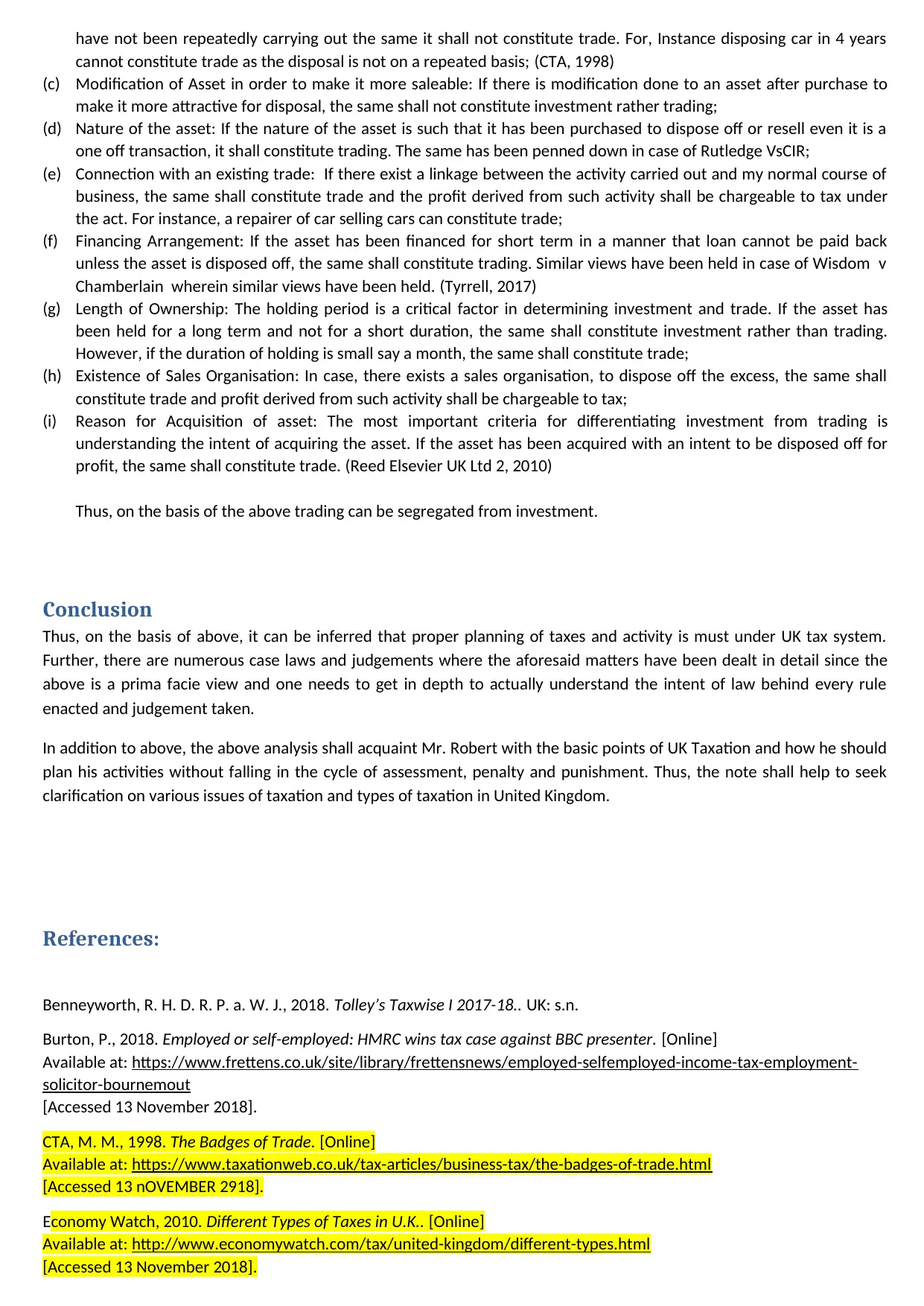
have not been repeatedly carrying out the same it shall not constitute trade. For, Instance disposing car in 4 years
cannot constitute trade as the disposal is not on a repeated basis; (CTA, 1998)
(c) Modification of Asset in order to make it more saleable: If there is modification done to an asset after purchase to
make it more attractive for disposal, the same shall not constitute investment rather trading;
(d) Nature of the asset: If the nature of the asset is such that it has been purchased to dispose off or resell even it is a
one off transaction, it shall constitute trading. The same has been penned down in case of Rutledge VsCIR;
(e) Connection with an existing trade: If there exist a linkage between the activity carried out and my normal course of
business, the same shall constitute trade and the profit derived from such activity shall be chargeable to tax under
the act. For instance, a repairer of car selling cars can constitute trade;
(f) Financing Arrangement: If the asset has been financed for short term in a manner that loan cannot be paid back
unless the asset is disposed off, the same shall constitute trading. Similar views have been held in case of Wisdom v
Chamberlain wherein similar views have been held. (Tyrrell, 2017)
(g) Length of Ownership: The holding period is a critical factor in determining investment and trade. If the asset has
been held for a long term and not for a short duration, the same shall constitute investment rather than trading.
However, if the duration of holding is small say a month, the same shall constitute trade;
(h) Existence of Sales Organisation: In case, there exists a sales organisation, to dispose off the excess, the same shall
constitute trade and profit derived from such activity shall be chargeable to tax;
(i) Reason for Acquisition of asset: The most important criteria for differentiating investment from trading is
understanding the intent of acquiring the asset. If the asset has been acquired with an intent to be disposed off for
profit, the same shall constitute trade. (Reed Elsevier UK Ltd 2, 2010)
Thus, on the basis of the above trading can be segregated from investment.
Conclusion
Thus, on the basis of above, it can be inferred that proper planning of taxes and activity is must under UK tax system.
Further, there are numerous case laws and judgements where the aforesaid matters have been dealt in detail since the
above is a prima facie view and one needs to get in depth to actually understand the intent of law behind every rule
enacted and judgement taken.
In addition to above, the above analysis shall acquaint Mr. Robert with the basic points of UK Taxation and how he should
plan his activities without falling in the cycle of assessment, penalty and punishment. Thus, the note shall help to seek
clarification on various issues of taxation and types of taxation in United Kingdom.
References:
Benneyworth, R. H. D. R. P. a. W. J., 2018. Tolley’s Taxwise I 2017-18.. UK: s.n.
Burton, P., 2018. Employed or self-employed: HMRC wins tax case against BBC presenter. [Online]
Available at: https://www.frettens.co.uk/site/library/frettensnews/employed-selfemployed-income-tax-employment-
solicitor-bournemout
[Accessed 13 November 2018].
CTA, M. M., 1998. The Badges of Trade. [Online]
Available at: https://www.taxationweb.co.uk/tax-articles/business-tax/the-badges-of-trade.html
[Accessed 13 nOVEMBER 2918].
Economy Watch, 2010. Different Types of Taxes in U.K.. [Online]
Available at: http://www.economywatch.com/tax/united-kingdom/different-types.html
[Accessed 13 November 2018].
cannot constitute trade as the disposal is not on a repeated basis; (CTA, 1998)
(c) Modification of Asset in order to make it more saleable: If there is modification done to an asset after purchase to
make it more attractive for disposal, the same shall not constitute investment rather trading;
(d) Nature of the asset: If the nature of the asset is such that it has been purchased to dispose off or resell even it is a
one off transaction, it shall constitute trading. The same has been penned down in case of Rutledge VsCIR;
(e) Connection with an existing trade: If there exist a linkage between the activity carried out and my normal course of
business, the same shall constitute trade and the profit derived from such activity shall be chargeable to tax under
the act. For instance, a repairer of car selling cars can constitute trade;
(f) Financing Arrangement: If the asset has been financed for short term in a manner that loan cannot be paid back
unless the asset is disposed off, the same shall constitute trading. Similar views have been held in case of Wisdom v
Chamberlain wherein similar views have been held. (Tyrrell, 2017)
(g) Length of Ownership: The holding period is a critical factor in determining investment and trade. If the asset has
been held for a long term and not for a short duration, the same shall constitute investment rather than trading.
However, if the duration of holding is small say a month, the same shall constitute trade;
(h) Existence of Sales Organisation: In case, there exists a sales organisation, to dispose off the excess, the same shall
constitute trade and profit derived from such activity shall be chargeable to tax;
(i) Reason for Acquisition of asset: The most important criteria for differentiating investment from trading is
understanding the intent of acquiring the asset. If the asset has been acquired with an intent to be disposed off for
profit, the same shall constitute trade. (Reed Elsevier UK Ltd 2, 2010)
Thus, on the basis of the above trading can be segregated from investment.
Conclusion
Thus, on the basis of above, it can be inferred that proper planning of taxes and activity is must under UK tax system.
Further, there are numerous case laws and judgements where the aforesaid matters have been dealt in detail since the
above is a prima facie view and one needs to get in depth to actually understand the intent of law behind every rule
enacted and judgement taken.
In addition to above, the above analysis shall acquaint Mr. Robert with the basic points of UK Taxation and how he should
plan his activities without falling in the cycle of assessment, penalty and punishment. Thus, the note shall help to seek
clarification on various issues of taxation and types of taxation in United Kingdom.
References:
Benneyworth, R. H. D. R. P. a. W. J., 2018. Tolley’s Taxwise I 2017-18.. UK: s.n.
Burton, P., 2018. Employed or self-employed: HMRC wins tax case against BBC presenter. [Online]
Available at: https://www.frettens.co.uk/site/library/frettensnews/employed-selfemployed-income-tax-employment-
solicitor-bournemout
[Accessed 13 November 2018].
CTA, M. M., 1998. The Badges of Trade. [Online]
Available at: https://www.taxationweb.co.uk/tax-articles/business-tax/the-badges-of-trade.html
[Accessed 13 nOVEMBER 2918].
Economy Watch, 2010. Different Types of Taxes in U.K.. [Online]
Available at: http://www.economywatch.com/tax/united-kingdom/different-types.html
[Accessed 13 November 2018].
⊘ This is a preview!⊘
Do you want full access?
Subscribe today to unlock all pages.

Trusted by 1+ million students worldwide
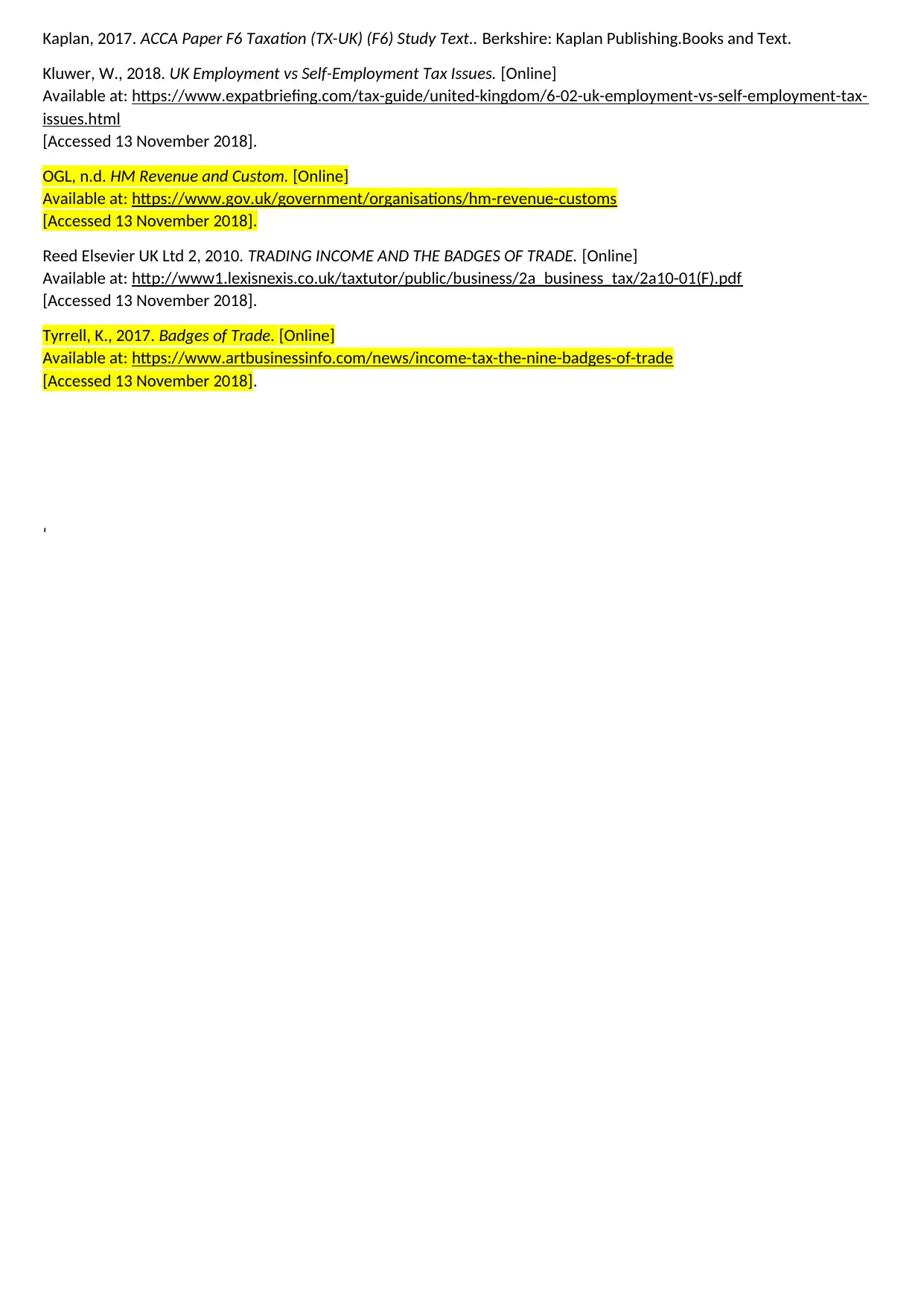
Kaplan, 2017. ACCA Paper F6 Taxation (TX-UK) (F6) Study Text.. Berkshire: Kaplan Publishing.Books and Text.
Kluwer, W., 2018. UK Employment vs Self-Employment Tax Issues. [Online]
Available at: https://www.expatbriefing.com/tax-guide/united-kingdom/6-02-uk-employment-vs-self-employment-tax-
issues.html
[Accessed 13 November 2018].
OGL, n.d. HM Revenue and Custom. [Online]
Available at: https://www.gov.uk/government/organisations/hm-revenue-customs
[Accessed 13 November 2018].
Reed Elsevier UK Ltd 2, 2010. TRADING INCOME AND THE BADGES OF TRADE. [Online]
Available at: http://www1.lexisnexis.co.uk/taxtutor/public/business/2a_business_tax/2a10-01(F).pdf
[Accessed 13 November 2018].
Tyrrell, K., 2017. Badges of Trade. [Online]
Available at: https://www.artbusinessinfo.com/news/income-tax-the-nine-badges-of-trade
[Accessed 13 November 2018].
‘
Kluwer, W., 2018. UK Employment vs Self-Employment Tax Issues. [Online]
Available at: https://www.expatbriefing.com/tax-guide/united-kingdom/6-02-uk-employment-vs-self-employment-tax-
issues.html
[Accessed 13 November 2018].
OGL, n.d. HM Revenue and Custom. [Online]
Available at: https://www.gov.uk/government/organisations/hm-revenue-customs
[Accessed 13 November 2018].
Reed Elsevier UK Ltd 2, 2010. TRADING INCOME AND THE BADGES OF TRADE. [Online]
Available at: http://www1.lexisnexis.co.uk/taxtutor/public/business/2a_business_tax/2a10-01(F).pdf
[Accessed 13 November 2018].
Tyrrell, K., 2017. Badges of Trade. [Online]
Available at: https://www.artbusinessinfo.com/news/income-tax-the-nine-badges-of-trade
[Accessed 13 November 2018].
‘
1 out of 7
Related Documents
Your All-in-One AI-Powered Toolkit for Academic Success.
+13062052269
info@desklib.com
Available 24*7 on WhatsApp / Email
![[object Object]](/_next/static/media/star-bottom.7253800d.svg)
Unlock your academic potential
Copyright © 2020–2025 A2Z Services. All Rights Reserved. Developed and managed by ZUCOL.





